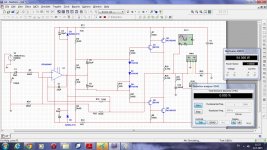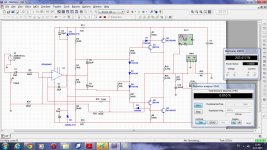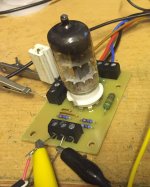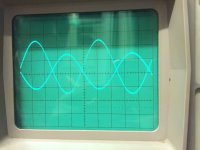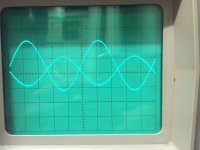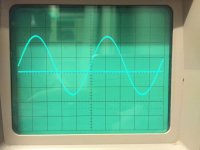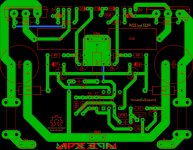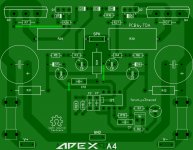I want to make it have high slew rate, then I change the compensation.
I like an amplifier that have high slew rate very much.
I revise the schematic because I miss type some value.
Please see my simulation file.
Attachments
Terry,
Thank You. Problem was with the 330p cap. Reflowed & now is working. Still have -40mv on output. 35mV across the emitter resistors. Total input power is 174ma idle. How do i adj. the -40ma on output
Rick
Hi Rick,
Yes with what Ivan said. This amp doesn't have an adjustment for offset. You might get it close by a closer match of the BC546 transistors but 40mV will not hurt anything.
It's done. Offset is around 15mV (1k8 || 75k instead of 1k5). Nice amplifier.Nice work, use 1k resistor in series with 1k pot instead 1k5 and set DC offset,
Regards
Next step is to combine with tube stage.
Question: I have just 6N1P and ECC82. Are there any changes compared to the ECC88 / 12AU7?
regards Olaf
6N1P has same pinout as ECC88 but is not the same. I have tried using 6N1P in four different circuits designed for the ECC88 and it just doesn't work. I really believe the circuit needs to be designed specifically for the 6N1P.
Hi Terry, thanks for the reply. I just try out everything 🙂
I'm worried anyway because of the low anode voltage.
We will see.
regards Olaf
I'm worried anyway because of the low anode voltage.
We will see.
regards Olaf
Hi Rick,
Yes with what Ivan said. This amp doesn't have an adjustment for offset. You might get it close by a closer match of the BC546 transistors but 40mV will not hurt anything.
Ivan & Terry,
OK, Thanks guys.
Last edited:
Waiting for the A0 release! 😀
The advantage of this circuit is rail to rail voltage swing without VAS, only single OP and two outputs is extra benefit.
VX120 with tube
Hi, here is the next step with the VX120:
I have the tube module connected with a ECC82 to the amplifier. With shorted input I measure over the 22k resistor 53 volts, which means it flow 2.4mA. That's not much.
Then the Input 0.4Vpp / 1kHz sine. The pictures show all things without changing the input from function generator:
1 No heating, no anode current, input 0.4Vpp, output is zero.
2 heating on, no anode current input is 0.35Vpp, output is inverted 0.2Vpp
3 Heating on, anode current flows, input is 0.4Vpp, output is inverted 0.25Vpp
4 amplifier input is 0.4Vpp, output is 8Vpp and looks good
But, when I connect a speaker or have a look at the scope at very low frequencies, the sound is like a machine gun. A "Blob" come with 5 to 10Hz and the resistors in the rails become very hot.
What is wrong? Sorry, I have absolutely no experience with tubes ...
regards Olaf
Hi, here is the next step with the VX120:
I have the tube module connected with a ECC82 to the amplifier. With shorted input I measure over the 22k resistor 53 volts, which means it flow 2.4mA. That's not much.
Then the Input 0.4Vpp / 1kHz sine. The pictures show all things without changing the input from function generator:
1 No heating, no anode current, input 0.4Vpp, output is zero.
2 heating on, no anode current input is 0.35Vpp, output is inverted 0.2Vpp
3 Heating on, anode current flows, input is 0.4Vpp, output is inverted 0.25Vpp
4 amplifier input is 0.4Vpp, output is 8Vpp and looks good
But, when I connect a speaker or have a look at the scope at very low frequencies, the sound is like a machine gun. A "Blob" come with 5 to 10Hz and the resistors in the rails become very hot.
What is wrong? Sorry, I have absolutely no experience with tubes ...
regards Olaf
Attachments
Last edited:
Yes, Zobel is installed and cool. When I use only the transistor part, all things are ok.Oscillation is causing the heat and motor boating. Do you have a zobel installed?
Regards Olaf
Yes, Zobel is installed and cool. When I use only the transistor part, all things are ok.
Regards Olaf
Maybe the gain is too high in the tube section.
- Home
- Amplifiers
- Solid State
- 100W Ultimate Fidelity Amplifier
